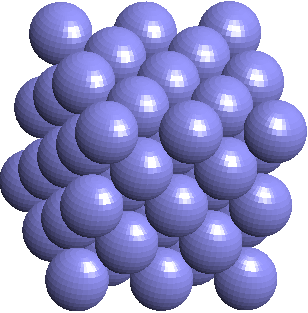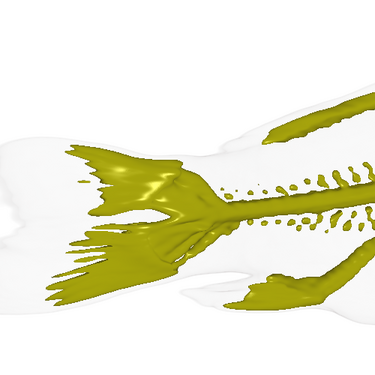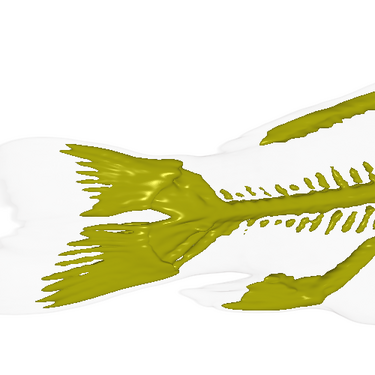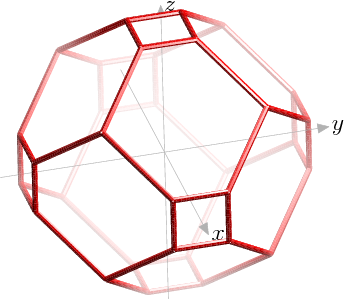| Quick Links and Educational Videos
This presentation
is a good overview of this research area.
This
lecture,
in solid state chemistry, is a good introduction to 3-D lattices and
how they appear in crystal structures.
Overview
The Cartesian
lattice is, quite commonly, the pattern of choice for
uniform sampling and approximation of data in many computing
applications. However, it turns out that Cartesian lattice is not the
best pattern for sampling and discretizing many continuous domain
functions. It has been proven that the Body Centered Cubic (BCC)
lattice is the best generic pattern for sampling and approximation of
tri-variate data. The optimality of the BCC lattice can be explained
by its inverse relationship to the densest sphere packing lattice-
the Face Centered Cubic (FCC) lattice.
 |
 |
| The BCC lattice |
FCC sphere packing |
As an example, here we have taken roughly the same number of samples
from a CT (Computerized Tomography) data set of a Carp fish,
left on the commonly used Cartesian lattice and right on the optimal
BCC lattice. Not only the BCC lattice provides a more accurate and
superior representation of the ribs and tail regions, it is
computationally twice more efficient than the Cartesian lattice.
 |
 |
| 2,744K Cartesian data points, 658 seconds |
2,735K BCC data points 335 seconds |
Similarly, this CT dataset of a porcelain teapot shows the attractive
properties of BCC optimal sampling pattern. The surface reconstructed
from the Cartesian data shows an artifact (hole) which is absent in
the optimal sampling case:
For a more detailed overview of my work, please see
this
presentation.
Research Question
Given the data properly sampled at BCC lattice points, how can one
interpolate or approximate (reconstruct) a continuous-domain function
from the given data points?
I learnt about box splines only when I realized that
Rhombic Dodecahedron
is a projection of a tesseract (4D
hypercube) along its antipodal axis. This incident is not hard to
observe in the lower dimensional cases.
- This box spline is represented by
This box spline and its self convolution helped us achieve really good
reconstructions on the BCC lattice. The shape of the ``first ring of
neighbours'' on the BCC lattice is a Rhombic Dodecahedron . See our BCC
reconstruction paper
that was published in IEEE Visualization
2004. In this paper, through some geometric arguments, we showed that
the linear box spline can be computed using the remarkably simple
explicit formula:
M (x, y, z) = 2 max(0, 1 - max( (x, y, z) = 2 max(0, 1 - max( x x + +  y y , , x x + +  z z , , y y + +  z z )) )) |
|
- However computation of the C^2 box spline remained really
costly at that time. Recently we managed to flesh out the polynomial
pieces constituting this fourth order box spline. Through this
explicit piecewise-polynomial representation, we achieved an extremely
fast reconstruction using this box spline.
It turns out that for a C^2 reconstruction using this box spline
with a fourth order approximation power we only need a neighborhood of
32 points. Similar smoothness and approximation order is achieved by
the tensor product tri-cubic B-spline on the Cartesian lattice by a
neighborhood of 4×4×4=64 points. Therefore, reconstruction
on the BCC lattice is twice faster than a similar reconstruction
on the Cartesian lattice.
- We demonstrated that not only the BCC lattice offers a more
accurate 'discrete' representation of many continuous-domain
functions, it also has attractive computational efficiency properties,
when compared to the usual Cartesian sampling lattice.
This paper
is going to appear in IEEE
TVCG. If you need to look at this work or need the code for such
reconstruction, feel free to email me.
- The Face Centered Cubic lattice is the ``dual'' of the BCC
lattice. The sincfunction on the BCC lattice is a function whose
Fourier domain representation is the indicator function of the Voronoi
cell of the dual lattice (i.e. the FCC lattice). Incidentally Rhombic Dodecahedron is
the Voronoi cell of the FCC lattice. Rhombic Dodecahedron can be decomposed into
four parallelepipeds. This decomposition
helped us derive the sincBCCfunction for the ideal interpolation
kernel on the BCC for the space of ``bandlimited'' functions. This is
explained in Section 5.1 in this PIMS/BIRS
publication.
- Also we have used the FCC and BCC lattices to find a 3D
multiresolution transform
that downsamples
by a factor of exactly two in each step. The tensor product way
of downsampling can only downsample by eight. I am looking in box
splines to find more suitable filters for this downsampling.
- I have also explored using a set of seven directional
tri-variate box splines for reconstruction of data sampled on the
regular Cartesian lattice. This work
shows how a
non-separable reconstruction kernel achieves reconstructions that
eliminates artifacts amplified by tensor product kernels. The support
of this kernel includes a total of 53 points which is 20% less
than the 64 points tri-cubic B-spline reconstruction uses. Therefore,
while the 7-directional box spline has the same smoothness and
approximation power of that of the tri-cubic B-spline, it is 20%
more efficient than tri-cubic B-spline. These tri-variate box
spline kernels are reminiscent of the well known Zwart-Powell element
in 2D. Jörg Peters, has already explored one of these box splines
for constructing curvature-continuous surfaces. You can take a look at
my VIS2006 slides.
Figure:
The Support of the 7-direction box spline: Truncated Rhombic Dodecahedron
|
 |
- The theoretical expectations is that the BCC sampling captures
more information from a given function with the same number of
samples as a Cartesian lattice. We have examined this theoretical
expectation and found an empirical evidence that a BCC sampled
volume with roughly about 70% number of samples of a Cartesian
volume produces equivalent visual quality.
- This paper
surveys the appearnce of hexagonal
sampling and BCC/FCC lattices in nature and in the computing domain.
|